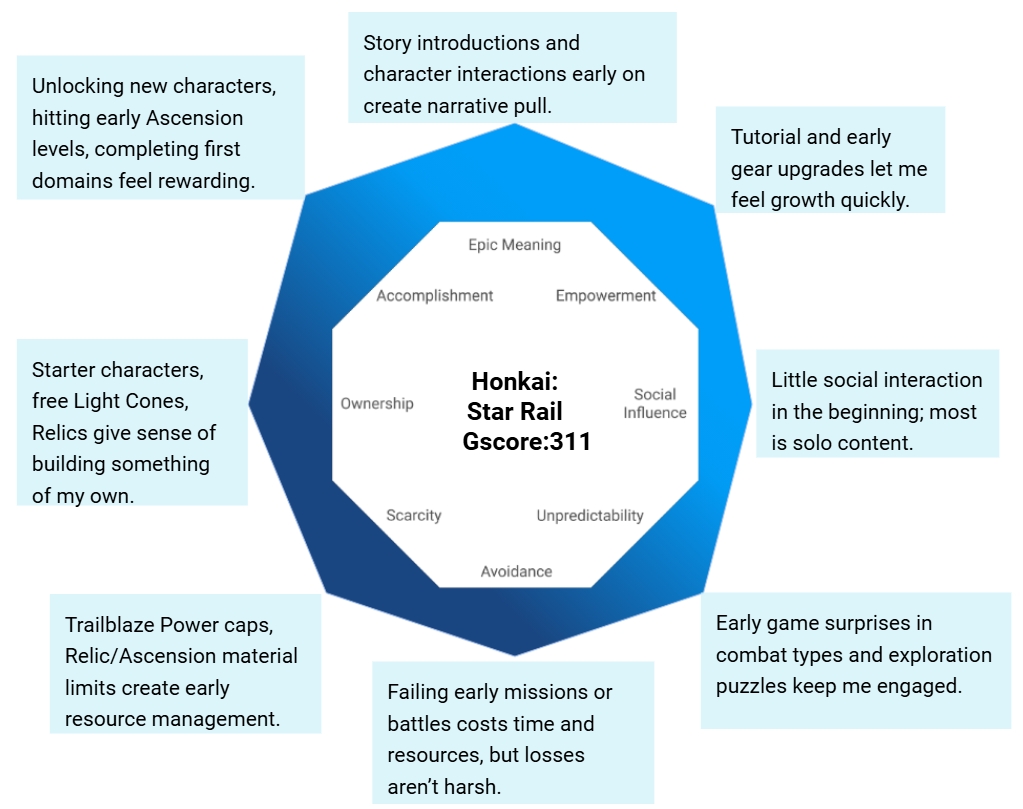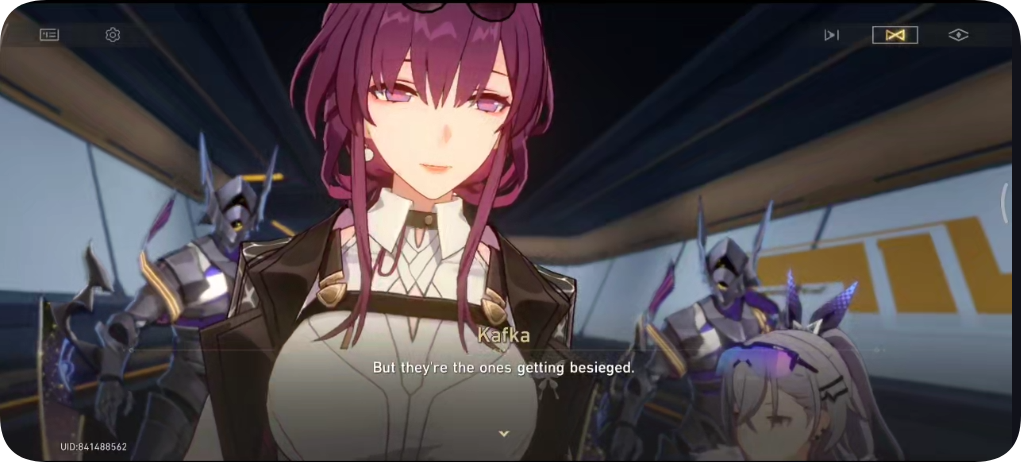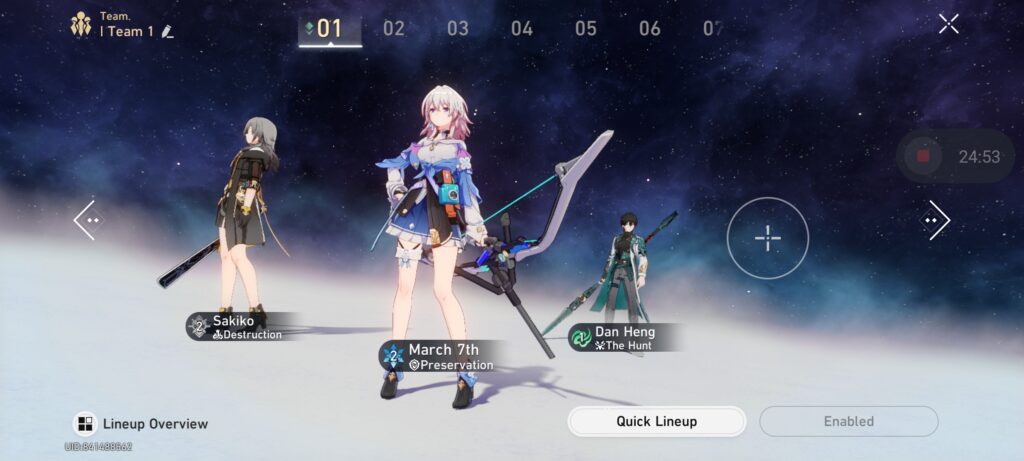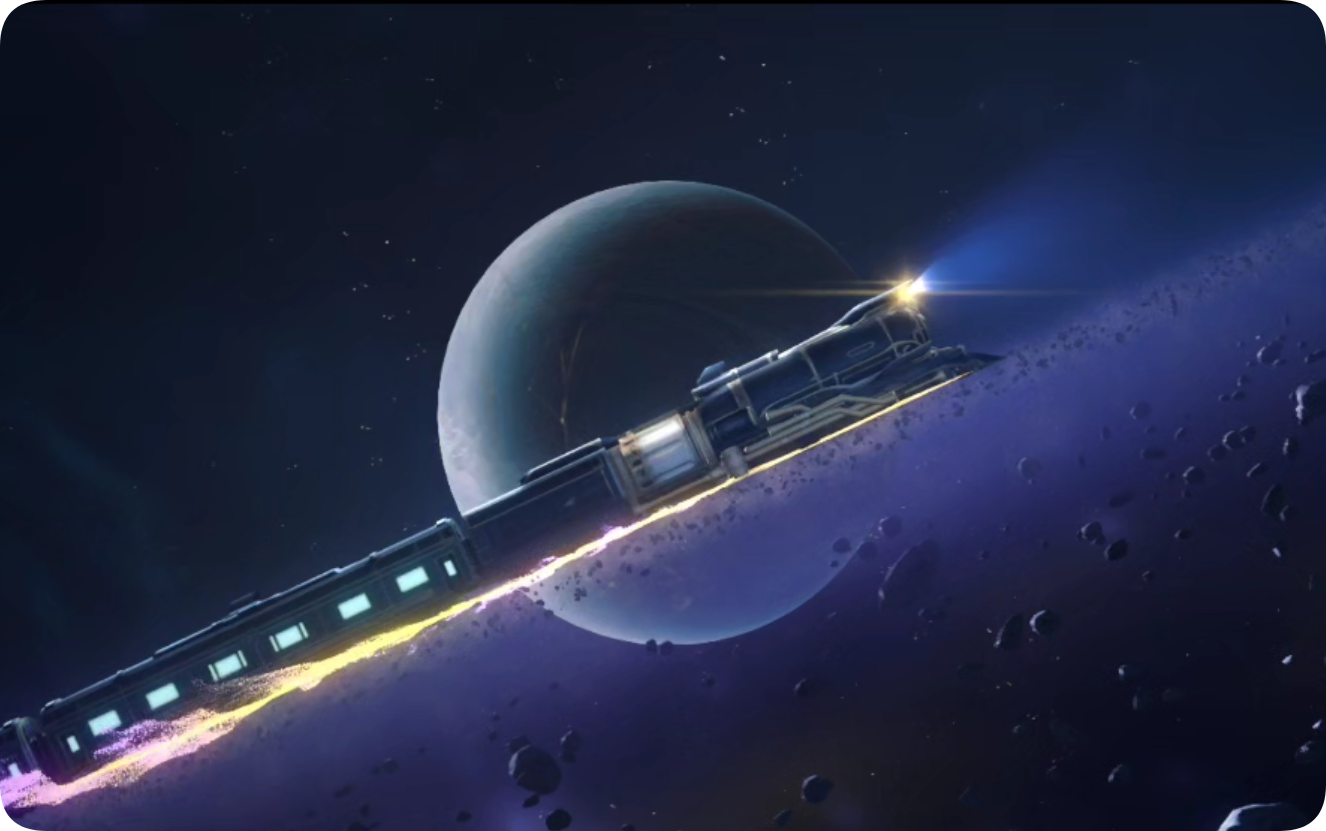A 9-minute uncut gameplay video:
In Honkai: Star Rail, during my first hours aboard the Astral Express, I was guided through tutorial Trailblaze Missions that introduced basic combat, Paths, and Light Cones. Early gameplay is focused on forming a starter team, leveling characters and Relics, and getting familiar with over-world exploration and the stamina-like Trailblaze Power system. The visuals and voice acting already impressed me, and the pacing of those early missions balances instruction and reward so I never felt overwhelmed even while learning many systems.
Octalysis Rating Table
| Core Drive | Score (1–10) | Brief Description |
|---|---|---|
| Meaning | 7 | Story introductions and character interactions early on create narrative pull. |
| Accomplishment | 8 | Unlocking new characters, hitting early Ascension levels, completing first domains feel rewarding. |
| Empowerment | 7 | Tutorial and early gear upgrades let me feel growth quickly. |
| Ownership | 6 | Starter characters, free Light Cones, Relics give sense of building something of my own. |
| Social Influence | 4 | Little social interaction in the beginning; most is solo content. |
| Scarcity | 6 | Trailblaze Power caps, Relic/Ascension material limits create early resource management. |
| Unpredictability | 6 | Early game surprises in combat types and exploration puzzles keep me engaged. |
| Avoidance | 5 | Failing early missions or battles costs time and resources, but losses aren’t harsh. |
Evaluation Notes:
Scoring range: 1-10. Higher scores reflect stronger implementation of the core drive and greater player motivation.
GScore (Gamification Score): Calculated using the Octalysis Framework tool.
Octalysis Radar Chart

Detailed Analysis
1. Meaning (7/10)
The early story missions introduce characters with personality and stakes—Trailblaze Missions give you glimpses into conflict and mystery, not just “beat this monster.” Even the first free Light Cones come with voice lines and lore that made me care.

2. Accomplishment (8/10)
Right after the tutorial I already felt rewarded: ascending a main character, equipping Relics, completing early story chapters—all gave meaningful power boosts. These early victories make you want to push on. When I cleared the first domain that drops good Relics, my team’s stats jumped noticeably—it was satisfying.
3. Empowerment (7/10)
I quickly got to choose my starter roster (which often includes Trailblazer, March 7th, others), decide on Relics, and tweak Light Cones. Upgrading Talents and Paths starts fairly early, so I could see results of my decisions.

4. Ownership (6/10)
From scratch I had access to free characters, a few Relics, and Light Cones. These give a sense of ownership: this is my team, my assets. Not all gear is perfect, but seeing my roster grow and items accumulate was motivating. I compare my relic sets early and that sense of “this is mine” builds quietly.
5. Social Influence (4/10)
New player stage is mostly solo—story missions, exploration, early side-quests. Co-op and leaderboard features unlock later. For now, watching other players or reading guides offers indirect competition. At first I felt alone on the Astral Express, but forums and social media told me how others were building, which helped me learn.
6. Scarcity (6/10)
Trailblaze Power acts like stamina: capped early and used for valuable resources, so I had to be deliberate about what I spent time on. Early Relic/Ascension materials are limited, so my decisions about which character to invest in feel meaningful. I found myself hoarding Enhancement Ore for just the right relic rather than upgrading every piece I get.
7. Unpredictability (6/10)
Even in the early chapters, combat encounters vary—enemy weaknesses, puzzle mechanics, Light Cone specials—that keep things interesting. Exploration surprises (e.g. interactables, hidden path sparkles) add delight. One battle had enemies resistant to a certain element I used—forced me to rethink my strategy mid-combat.
8. Avoidance (5/10)
Failing a battle early costs resources or mission repeat, but nothing permanent breaks. This low-penalty setup encourages experimentation without harsh frustration. I died a few times learning how Path buffs and Break work, but restarting didn’t feel like a setback—it felt like learning.
Overall Summary & Recommendation
If you’re new to Honkai: Star Rail, its tutorial and early game do an excellent job introducing its systems, combat, and character progression without overwhelming you. The strongest early game strengths are Accomplishment and Meaning—completing early missions, claiming rewards, and uncovering lore make you feel oriented and motivated. Scarcity and social features are weaker initially, but that’s understandable. I’d recommend this game to RPG players who value narrative, team building, and gradual growth. For full mastery and social engagement, there’s more ahead—but for new players, this is a very solid start.


Leave a Reply